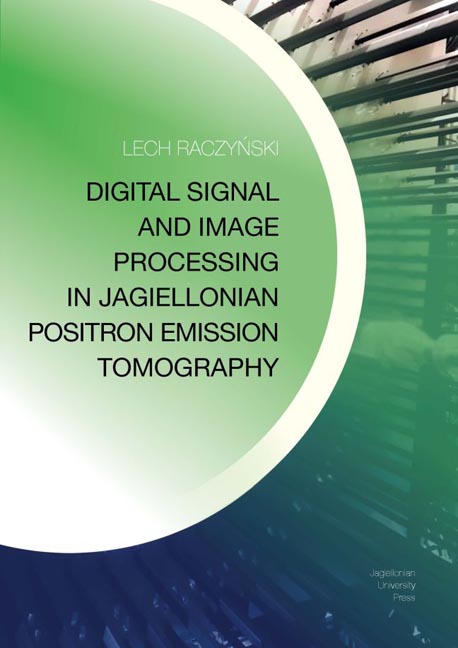Book contents
- Frontmatter
- Dedication
- Acknowledgements
- Contents
- Abbreviations
- Preface
- 1 Introduction
- 2 Positron Emission Tomography
- 3 Algorithmic background
- 4 Low-level data processing in Jagiellonian PET
- 5 High-level data processing in Jagiellonian PET
- 6 Results
- 7 Conclusions and summary
- Appendix
- References
- Miscellaneous Endmatter
5 - High-level data processing in Jagiellonian PET
Published online by Cambridge University Press: 13 October 2023
- Frontmatter
- Dedication
- Acknowledgements
- Contents
- Abbreviations
- Preface
- 1 Introduction
- 2 Positron Emission Tomography
- 3 Algorithmic background
- 4 Low-level data processing in Jagiellonian PET
- 5 High-level data processing in Jagiellonian PET
- 6 Results
- 7 Conclusions and summary
- Appendix
- References
- Miscellaneous Endmatter
Summary
This chapter describes the subsequent steps of high-level data processing in the J-PET scanner. The goal of high-level reconstruction is an estimation of radioactive tracer distribution injected to the patient’s body. The image reconstruction is based on information on registered set of events of positron-electron annihilations. As it was discussed in the previous chapter, a single event is derived based on the detection of both γ photons in two scintillators in a narrow time window.
In recent years, PET data acquisition has been shifted to list-mode [10], where each registered event is saved individually. Storing coincidence events individually, instead of accumulated counts in sinogram, is preferred for efficient data processing for whole-body PET scanners that additionally record TOF information. Moreover, in listmode data, each event may be described with additional information such as, e.g., deposited energy in the scintillators, detection time difference. Therefore, each event may be described with preselected set of features, creating high-dimensional feature space.
During the PET examination, an event is regarded as valid if: two γ photons are registered within a predefined time window, and the energy deposited in the scintillator by both γ photons exceeds the selected threshold. However, a number of events registered as having met the above criteria are undesirable. Different types of events in PET measurement are:
• true. Pair of γ photons derive from a single positron-electron annihilation and reach the scintillators without interacting with the atoms in detector volume.
• random. Pair of γ photons derive from two different positronelectron annihilations occur at approximately the same time.
• scattered. Pair of γ photons derive from a single positron-electron annihilation when one or both of them have undergone a Compton interaction.
As the true events are essential for the PET imaging, the random and scattered events distort the reconstructed distribution of radiotracer.
This chapter is organized as follows. First, in section 5.1, the method for classification of events will be proposed. For this purpose we apply a self-organizing map (SOM) network to analyse the high-dimensional feature space created by a set of three types of events. In particular, we provide a visualisation of high-dimensional feature space and we investigate the class distributions on a 2-dimensional SOM.
- Type
- Chapter
- Information
- Publisher: Jagiellonian University PressPrint publication year: 2021



